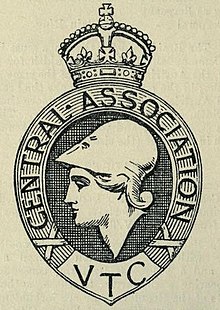The Volunteer Training Corps (VTC) was a voluntary home defence militia which was the First World War equivalent of the Home Guard. When war was declared in August 1914, there was an immediate demand for a means of service for those men who were over military age or engaged in important occupations. Combined with the perceived risk of a German invasion, this resulted in the spontaneous formation of volunteer defence associations around the country. By September 1914, a central committee had been formed. It was renamed the Central Association of Volunteer Training Corps in November 1914 and recognised by the War Office.
Numerous Corps were formed all over Worcestershire. George Edwin Jones, a 44-year-old market gardener who lived on Sands Lane, Badsey, was Honorary Secretary of the Badsey branch of the Evesham and District Volunteer Training Corps. The branch met at the old school room (the building now known as The Pub in a Club). Each week a notice was posted in The Evesham Journal giving orders for the week detailing when drills and shooting practice were to take place. A number of reports in The Evesham Journal (19th December 1914, 8th March 1915, 20th March 1915, 27th March 1915) indicate that the local corps was very active. The Evesham and District Corps became affiliated to the Central Association on 6th March 1915. The Badsey Parish Magazine of April 1915 noted that about 70 members of Evesham and District Volunteer Training Corps were present for a parade at Badsey Church on Sunday evening, 21st March.
Units had to be financially self-supporting and members had to provide their own uniforms, which could not be khaki. Members of the VTC wore a red brassard or armband bearing the letter ‘GR’ for Georgius Rex.
Although the Central Association had been officially recognized, the new Volunteer Training Battalions were not. It was discovered that the Volunteer Act of 1863 had never been repealed and the VTC Battalions legally became Volunteer Regiments in July 1915 – thus the 1st, 2nd and 3rd Volunteer Battalions of the Worcestershire Regiment came into being. The Evesham branch was part of the 2nd Battalion with headquarters at Worcester.

The Volunteer Training Corps became more firmly established in 1916 after the introduction of conscription into the Armed Services in March. As a consequence of conscription, there was a necessity for Military Service Tribunals to hear the cases of men wishing to avoid service for a range of reasons. Some of these men were granted exemption on condition that they join the VTC.
In August 1916, the War Office decided to take over the Volunteer Training Corps, volunteers being attested under the old Volunteer Act of 1863. The Worcestershire Volunteer Regiment was formally accepted as a regiment of the new Volunteer Force and its officers were granted temporary commissions. December, the Volunteer Act of 1916 was passed. Once the Volunteer Act came into force, men who were directed to join the VTC had to sign Army Form V.4010, “Volunteer Force, Agreement under the Volunteer Act, 1916 – Drills and Training (Volunteers)”, in which they had to confirm:
- I do hereby agree that for the duration of the present war I will attend at least ten drills (or substitutes for drills) a month of such a character as may be directed from time to time by Volunteer Regulations, and, if I am not passed by such authority as the Army Council may prescribe, a further number of four such drills (or substitutes for drills) a month until I am so passed.
- I understand that I cannot be relieved of the obligation under this agreement, or, while this agreement is in force, quit my corps, except on the recommendation of my Commanding Officer and under the authority of the Army Council or such officer as may be deputed by them for the purpose.
- I understand that any failure on my part to comply with this agreement may be dealt with as an offence under military law in accordance with the Volunteer Act, 1916.
- I understand that, during the continuance of this agreement, I shall be subject to military law as a soldier while engaged in any drill, exercise or training, or while performing any military duty.
No personal service records exist for the VTC and no campaign medals were given for home service, so the only information on men who went into these units comes from newspaper tribunal reports. Nationally, by February 1918 there were 285,000 volunteers of whom 101,000 had been directed to the Corps by Tribunals. The Corps was disbanded at the end of the War.
Further Reading
- An article appeared in The Spectator of 22nd April 1916 about the Volunteer Training Corps.
- Malcolm Atkin, the retired County Archaeologist for Worcestershire, is writing a book (together with Mick Wilks) on Worcestershire Volunteer Training Corps and Volunteer Force, to be published later this year. An introduction to their research may be viewed on the Worcestershire VTC website.
